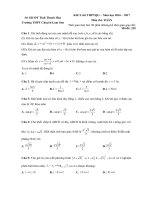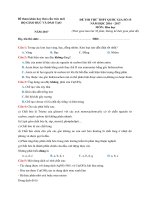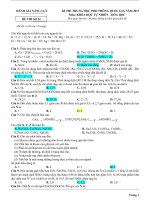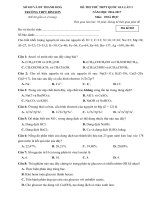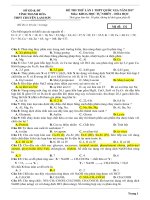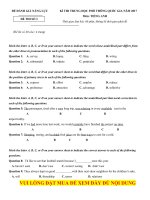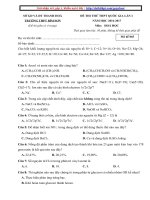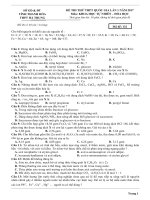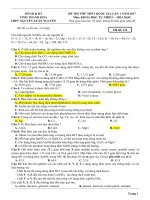đề hóa theo cấu trúc mới năm 2017 đề 5 có lời giải
Bạn đang xem bản rút gọn của tài liệu. Xem và tải ngay bản đầy đủ của tài liệu tại đây (206.87 KB, 17 trang )
ĐỀ ĐÁNH GIÁ NĂNG LỰC
ĐỀ THI SỐ 5
KÌ THI TRUNG HỌC PHỔ THÔNG QUỐC GIA NĂM 2017
Môn: TIẾNG ANH
Thời gian làm bài: 60 phút, không kể thời gian phát đề
(Đề thi có 40 câu / 4 trang)
Read the following passage and mark the letter A, B, C or D on your answer sheet to indicate
the correct word for each of the blanks.
Any change in one part of an ecosystem can cause changes in other parts. Droughts, storms
and fires can change ecosystems. Some changes (1) _________ ecosystems. If there is too (2)
_________ rainfall, plants will not have enough water to live. If a kind of plant dies off, the animals
that feed on it may also die or move away. Some changes are good for ecosystems. Some pine forests
need fires for the pine trees to reproduce. The seeds are sealed inside pinecones. Heat from a forest
fire melts the seal and lets the seeds (3) _________. Polluting the air, soil, and water can harm
ecosysterms. Building (4)_________ on rivers for electric power and irrigation can harm ecosystems
around the rivers. Bulldozing wetlands and cutting down forests destroy ecosystems. Ecologists are
working with companies and governments to find better ways of (5) _________ fish, cutting down
trees, and building dams. They are looking for ways to get food, lumber, and other products for people
without causing harm to ecosystems.
Question 1. A. harms
B. harmful
C. harmless
D. harm
VUI LÒNG ĐẶT MUA
ĐỂ XEM ĐẦY ĐỦ NỘI DUNG
Question 4. A. moats
B. ditches
C. bridges
D. dams
Question 5. A. catching
B. holding
C. carrying
D. taking
Mark the letter A, B, C, or D on your answer sheet to indicate the word whose underlined part
that differs from the other three in thepronunciation in each of the following questions.
Question 6: A. state
B. status
C. station
D. statue
Question 7: A. bury
B. carry
C. heavy
D. many
Mark the letter A, B, C, or D on your answer sheet to indicate the word that differs from the
rest in the position of the main stress in each of the following questions.
Question 8: A. popularity
B. conscientious
C. apprenticeship
D. personality
Question 9: A. consonant
B. divisible
C. significant
D. mosquito
Read the following passage and mark the letter A, B, C or Don your answer sheet to indicate the
correct answer
In the last third of the nineteenth century a new housing form was quietly being developed. In
1869 the Stuyvesant, considered New York’s first apartment house was built on East Eighteenth
Street. The building was financed by the developer Rutherfurd Stuyvesant and designed by Richard
Morris Hunt, the first American architect to graduate from the Ecole des Beaux Arts in Paris. Each
man had lived in Paris, and each understood the economics and social potential of this Parisian
housing form. But the Stuyvesant was at best a limited success. In spite of Hunt’s inviting facade, the
living space was awkwardly arranged. Those who could afford them were quite content to remain in
the more sumptuous, single-family homes, leaving the Stuyvesant to newly married couples and
bachelors.
The fundamental problem with the Stuyvesant and the other early apartment buildings that
quickly followed, in the 1870’s and early 1880’s was that they were confined to the typical New York
building lot. That lot was a rectangular area 25 feet wide by 100 feet deep-a shape perfectly suited for
a row house. The lot could also accommodate a rectangular tenement, though it could not yield the
square, well-lighted, and logically arranged rooms that great apartment buildings require. But even
with the awkward interior configurations of the early apartment buildings, the idea caught on. It met
the needs of a large and growing population that wanted something better than tenements but could
not afford or did not want row houses.
So while the city’s newly emerging social leadership commissioned their mansions, apartment
houses and hotels began to sprout in multiple lots, thus breaking the initial space constraints. In the
closing decades of the
Question 10: The new housing form discussed in the passage refers to
A. single-family homes
B. apartment buildings
C. row houses
D. hotels
Question 11: The word “inviting” in bold is closest in meaning to
A. open
B. encouraging
C.attractive
D. asking
Question 12: Why was the Stuyvesant a limited success?
A. The arrangement of the rooms was not convenient.
B. Most people could not afford to live there,
C. There were no shopping areas nearby.
D. It was in a crowded neighborhood.
Question 13: It can be inferred that the majority of people who lived in New York’s first apartments
were
A. highly educated
B. unemployed
C.wealthy
D. young
Question 14: It can be inferred that a New York apartment building in the 1870’s and 1880’s had all
of the following characteristics EXCEPT:
A. Its room arrangement was not logical.
B.It was rectangular,
C. It was spacious inside.
D.It had limited light.
Question 15: The word “yield” in bold is closest in meaning to
A.
harvest
B. surrender
C. amount
D. provide
Question 16: Why did the idea of living in an apartment become popular in the late 1800’s?
A. Large families needed housing with sufficient space.
B. Apartments were preferable to tenements and cheaper than row houses
C. The city officials of New York wanted housing that was centrally located.
D. The shape of early apartments could accommodate a variety of interior designs.
Question 17: The author mentions the Dakota and the Ansonia in bold because
A. they are examples of large, well-designed apartment buildings
B. their design is similar to that of row houses
C. they were built on a single building lot
D. they are famous hotels
Mark the letter A, B, C, or D to indicate the word or phrase that is OPPOSITE in meaning to
the italic part in each of the following questions
Question 18: Mr. Smith’s new neighbors appear to be very friendlỵ.
A. amicable
B. inapplicable
C. hostile
D. futile
Question 19: The clubs meet on the last Thursday of every month in a dilapidated palace.
A. renovated
B. regenerated
C. furnished
D. neglected
Mark the letter A, B, C, or D on your answer sheet to indicate the correct answer to each of the
following questions.
Question 20:____________we’re been having!
A. What dreadful weather
B. How dreadful is the weather
C. How dreadful the weather
D. What a dreadful weather
Question 21: They__________have seen the play last night as they went to a football match instead.
A. could
B. must
C. might
D. can't
Question 22:“_______” “Not really.”
A. I don't like that new movie.
B. Would you like to watch a cartoon or a documentary?
C. Would you recommend the new movie at the Odeon?
D. How often đo you go to the movies?
Question 23: Something tells me that you_______to a single word I_______in the past ten minutes.
A. haven’t listened\was saying
B. didn’t listen\ said
C. haven’t been listening\ have said
D. haven’t listened\ said
Question 24: The________horse began to run as fast as he could.
A. frightening
B. frighten
C. frightful
D. frightened
Question 25: The police spokesman said he was_________to believe that the arrested man was the
serial killer they
had been looking for.
A. inclined
B. seemed
C. suspected
D. supposed
Question 26: For lunch, I always have something quick and easy: a sandwich, a salad, toast and the
________.
A. same
B. similar
C. like
D. rest
Question 27:1 don’t think anyone understood what I was saying at the meeting, did they? I totally
failed to get my point ________.
A. around
B. along
C. across
Question 28: This fruit has been in the fridge for over three weeks! It is all
A. sour
B. mouldy
D. about
.
C. rotten
D. bitter
Question 29: As I have just had a tooth_________, I am not allowed to eat or drink anything for three
hours.
A. Taken out
B. crossed out
C. broken off
D. tried on
Question 30: We don't seem to have any more of that book, Sir. It is out of_________but we are
getting a new delivery next Thursday if you would like to pop back then.
A. stock
B. order
C. print
D. shop
Question 31: - "What do you think of football?" -"_______"
A. I am crazy about it.
B. Of course, football players are excellent
C. Well, it's beyond my expectation
D. It's none of my business.
Question 32: As coal mines became deeper, the problems of draining water, bringing in fresh air, and-------to
the surface increased.
A. how ore is transported
B. transporting ore
C. ore is transporting
D. to transport ore
Question 33: I'm_________my brother is.
A. nowhere near as ambitious as
B. nothing near as ambitious as
C. nowhere like so ambitious as
D. nothing as ambitious as
Mark the letter A, B, c or D to indicate the word or phrase that is CLOSEST in meaning to the
italic part in each of the following questions
Question 34: He didn’t hat an eye when he realized he failed the exam again.
A. didn’t want to see
B. didn’t show surprise
C. wasn’t happy
D. didn’t care
Question 35: The changes in a person's physical and emotional state caused by drinking alcohol are
known as intoxication.
A. Drunkenness
B. Poison
C. sleepiness
D. Excitement
Read the following passage and mark the letter A, B, C or D on your answer sheet to indicate
the correct answer.
Are organically grown foods the best food choices? The advantages claimed for such foods over
conventionally grown and marketed food products are now being debated. Advocates of organic
foods-a term whose meaning varies greatly - frequently proclaim that such products are safer and
more nutritious than others.
The growing interest of consumers in the safety and more nutritional quality of the typical North
American diet is a welcome development. However, much of this interest has been sparked by
sweeping claims that the food supply is unsafe or inadequate in meeting nutritional needs. Although
most of these claims are not supported by scientific evidence, the preponderance of written material
advancing such claims makes it difficult for the general public to separate fact from fiction. As a
result, claims that eating a diet consisting entirely of organically grown foods prevents or cures
disease or provides other benefits to health have become widely publicized and form the basis for
folklore.
Almost daily the public is besieged by claims for “no-aging" diets, new vitamins, and other
wonder foods. There are numerous unsubstantiated reports that natural vitamins are superior to
synthetic ones, that fertilized eggs are nutritionally superior to unfertilized eggs, that untreated grains
are better than fumigated grains and the like.
One thing that most organically grown food products seem to have in common is that they
cost more than conventionally grown foods. But in many cases consumers are misled if they
believe organic foods can maintain health and provide better nutritional quality than
conventionally grown foods. So there IS real cause for concern if consumers, particularly those
with limited incomes, distrust the regular food and buy only expensive organic foods instead.
Question 36: The world "Advocates" is closest in meaning to which of the following?
A. Proponents
B. Merchants
C. Inspectors
D. Consumers
C. organic foods
D. products
Question 37: The word "others" refers to_________.
A advantages
B. advocates
Question 38: The "welcome development" is an increase in_____________.
A. interest in food safety and nutritional quality of the typical North American diet
B. the nutritional quality of the typical North American diet
C. the amount of healthy food grown in North America
D. the number of consumers in North America
Question 39: According to the first paragraph, which of the following is true about the term "organic
foods"?
A. It is accepted by most nutritionists,
B. It has been used only in recent years,
C. It has no fixed meaning.
D. It is seldom used by consumers.
Question 40: The author implies that there is cause for concern if consumers with limited incomes
buy organic foods instead of conventionally grown foods because _________.
A. organic foods can be more expensive but are often no better than conventionally grown foods
B. many organic foods are actually less nutritious than similar conventionally grown foods
C. conventionally grown foods are more readily available than organic foods
D. too many farmers will stop using conventional methods to grow food crops.
Question 41: According to the last paragraph, consumers who believe that organic foods are better
than conventionally grown foods are often _________.
A. careless
B. mistaken
C. thrifty
D. wealthy
Question 42: What is the one thing in common that most organic food seem to have?
A. They cost more than conventionally grown food
B.
They are healthier than conventionally grown food
C. They come from an unknown source
D. They are home - made
Mark the letter on your answer sheet to show the underlined part that needs correcting.
Question 43: After the social science lecture all students are invited to take part in a discussion
A
B
of the issues which were risen in the talk.
C
D
Question 44: A football match begins with the ball kicking forwards from a spot in the centre of the
A
B
C
D
field.
Question 45: They had a discussion about training not only the new employees but also giving them
A
B
C
some challenges.
D
Mark the letter A, B, C, or D to indicate the sentence that best combines each pair of sentences
in the following questions.
Question 46 The match on Sunday is very popular. It was wise of him to buy the tickets in advance.
A. Since it is a popular match, he should have brought the tickets beforehand.
B. Although he bought the tickets in advance, he wasn’t wise to forsee the match popularity,
C. Such is the popularity of the match on Sunday that he wisely bought the tickets beforehand.
D. The match on Sunday is so popular that he had enough wisdom to buy the tickets in advance.
Question 47: We arrived at airport. We realized our passports were still at home.
A. It was until we arrived at the airport that we realize our passports were still at home.
B. We arrived at the airport and realized that our passports arc still at home,
C. Not until had we aưivcd at the airport, we realized our passports were still at home.
D. Not until we arrived at the airport, did wc realize that our passports were still at home.
Mark the letter A B c or D on your answer sheet to choose the sentence winch is closest in
meaning to the given one.
Question 48 Friendly though he may seem, he’s not to be trusted.
A. He's too friendly to be trusted.
B. However he seems friendly, he's not to be trusted,
C. He may have friends, but he’s not to be trusted.
D. However friendly he seems, he's not to be trusted,
Question 49: “You’re always making terrible mistakes”, said the teacher.
A The teacher asked his students why they always made terrible mistakes.
B The teacher realized that his students always made terrible mistakes,
C. The teacher complained about his students making terrible mistakes.
D. The teacher made his students not always make terrible mistakes.
Question 50: The criminal is believed to be living abroad
A. There’s a belief that that the criminal should be living abroad.
B. It is believed that the criminal is living abroad,
C. The belief is that the criminal should be living abroad.
D. It believes that the criminal is living abroad.
ĐÁP ÁN VÀ GIẢI THÍCH CHI TIẾT
1D
11C
21D
31A
41B
2A
12A
22C
32B
42A
3A
13D
23C
33A
43D
4D
14C
24D
34B
44C
5A
15D
25A
35A
45B
6D
16B
26C
36A
46C
7B
17A
27C
37D
47D
8C
18C
28C
38A
48D
9A
19C
29A
39D
49C
10B
20A
30A
40A
50B
GIẢI THÍCH CHI TIẾT
Question 1: Chọn D
Tạm dịch:...Some changes (1)_____ecosystems:
Một sổ thay đổi_________tới các hệ sinh thái.
Harms (v) (gây hại)
Harmful: (adj) (có hại)
Harmless (ađj) (vô hại)
Harm (v) (gây hại)
Câu cần điền chưa có động từ, loại đáp án B và C. Chủ ngữ “some changes” là số nhiều, loại đáp án
A.
Question 2: Chọn A
Tạm dịch: ... If there is too (2)__________ rainfall, plants will not have enough water to live;
Nếu lượng mưa quá ________ thực vật sẽ không có đủ
)
A few: ít nhưng đủ dùng (dùng với danh từ đêm đtrợc, mang nét nghĩa tỉch cực)
Vì có “too” nên câu mang nét nghĩa tiêu cực, danh từ “rainfall” lượng mưa không đếm được.
Question 3: Chọn A
Tạm dịch: .. Heat from a forest fire melts the seal and lets the seeds (5)________:
Sức nóng từ cháy rừng sẽ làm tan chày các mối bít và thả các hạt_________:
A. out
B.in
C.go
D. fly
Một cách lô gíc, khi có sức nóng khiến các mối bít tan chảy thì các hạt bị tắc ở trong trước đó sẽ có
thể rơi ra ngoài. Mỗi bít không còn để các hạt ớ trong không hợp lý loại đap án B. Loại C và D vì các
hạt không thể đi và bay. Để các hạt ra ngoài là đáp án phù hợp nhất. Do đó đáp án đúng là A.
Question 4: Chọn D
Tạm dich: Building (6) ________on rivers for
electric power and irrigation can harm ecosystems (7) ________ the rivers: Xây ________ trên sông
làm thủy điện và tưới tiêu cũng gây hại tới hệsình thái ________ dòng sông
Moats: hào (xung quanh thành tri)
Ditches (hào, rãnh, mương)
Bridges (cầu)
Dams (đập)
Loại đáp án A vì hào này chỉ xây quanh thành trì. Loại đáp án B vì quanh sông không có hào, rãnh,
mương không dùng làm thủy điện. Xây cầu bắc qua sông cũng không trực tiếp sử dụng làm thủy điện
và tưới tiêu, cũng ít gây ảnh hường đến hệ sinh thái hơn, loại đáp án C. Đập xây trên sông để làm thủy
điện và phục vụ tưới tiêu.
Question 5: Chọn A
Tạm dich: ... Ecologists are working with companies and governments to find better ways of (9)
________ fish, cutting down trees, and building dams: Các nhà sình thái học đang hợp tác cùng các
doanh nghiệp và chính phủ để tìm ra phương thức ________ cá, chặt rừng và xây đập tốt hơn.
Catching (đánh bẳt, tóm)
Holding (cầm, giữ)
Carrying (mang, vác)
Taking (lấy)
Đánh bắt cá chúng ta sử dụng “to catch fish”. Các đáp án không hợp nghĩa.
Vậy đáp án A là hợp lý nhât.
VUI LÒNG ĐẶT MUA ĐỂ XEM ĐẦY ĐỦ NỘI
DUNG
Question 12: Chọn A
Keywords: Stuyvesant, a limited success
Clue: ‘In spite of Hunt’s inviting facade, the living space was awkwardly arranged”: Thay vì mặt tiền
hấp dẫn của Hunt, nơi sống lại được bổ trí rất vụng về
Như vậy có thể thấy những phòng ờ Stuyvesant bố trí không hợp lí, không thuận tiện.
Chọn A. The arrangement of the rooms was not convenient. (Cách bố trí phòng không thuận tiện)
Question 13: Chọn D
Clue: “...leaving the Stuyvesant to newly married couples and bachelors” :...bỏ lại Stuyvesant cho
những cặp đôi mới cưới và những cử nhân.
Như vậy những người sống trong khu chung cư đầu tiên của New York (Stuyvesant) chủ yểu là những
người trẻ. Do đó đáp án đủng phải là D.
Question 14: Chọn C
Clue: “...though it could not yield the square, well- lighted, and logically arranged rooms that great
apartment buildings require”:...mặc dù nó không thể mang lại những căn phòng vuông vức, ảnh sảng
đầy đủ và và sự bố tri hợp tí mà một căn hộ cao cáp yêu cầu.
Như vậy chỉ có đáp án c là không được đề cập
Question 15: Chọn D
yield (v): mang lại = provide (v)
Question 16: Chọn B
Clue: “But even with the awkward interior
configurations of the early apartment buildings, the idea caught on. It met the needs of a large and
growing population that wanted something better than tenements but could not afford or did not want
row houses. Nhưng ngay cả với cách bày trí nội thất vụng về cùa nhũng căn hộ cao cấp ban đầu, ý
tưởng sống ở đó vẫn phố biến. Nó đáp ứng nhu cầu việc số lượng lớn và ngày càng gia tăng người
dân muốn cái gì đó tốt hơn chung cư nhưng lại không có điều kiện trả hoặc không muốn nhà liên kết.
Như vậy lí do sống ở căn hộ phổ biển ở cuối những năm 1800 là B. Apartments were preferable to
tenements and cheaper than row houses: Căn hộ thì thích hợp hơn là chung cư và rẻ hơn nhà liên kết.
Question 17: Chọn A Keywords: Dakota and the Ansonia Clue: “...spacious buildings, such as the
Dakota and the Ansonia finally transcended the tight confinement of row house building lots. From
there it was only a small step to building luxury apartment houses. ” ;„.những tòa nhà rộng rãi, như
là “Dakota and the Ansonia” cuối cùng cũng vượt ra khói sự kìm hãm của những tòa nhà liên kết, Từ
đây thì chỉ một bước nhỏ nữa thôi là có thể xây dựng những căn hộ lộng lẫy.
Như vậy “Daktoa and the Ansonia” là ví dụ của những căn hộ cao cấp rộng lớn, thiết kể đẹp.
Question 18: Chọn C
Tạm dịch: Không ai biết chính xác điều gì sẽ xảy ra đối với một con người đang ở trong vũ trụ.
Amicable (adj) (thân mật, thân tình)
Inapplicable (adj) (không thể áp dụng được, không thể ứng dụng được)
Hostile (adj) (không thân thiện, thái độ thù địch)
Futile (adj) (vô ích, không có hiệu quà)
Friendly: thân thiện. Do đó đáp án phải là hostile.
Question 19: Chọn C
Tạm dịch: Các câu lạc bộ họp mặt vào thứ năm cuối cùng cùa mỗi tháng tại một nơi.
Renovated (v) (làm mới lại, đỏi mới; cái tiến, sừct chữa lại)
Regenerated (v) (tái sinh, phục lại)
Furnished (adj) (có sẵn đồ đạc, được trang bị đồ đạc)
Neglected (adj) (sao lãng, không chú ý, bỏ bê, thờ ơ)
Dilapidated (adj): đổ nát, xiêu vẹo, ọp ẹp (nhà)
Do đó đáp án phải là C, vì yêu cầu đề tìm từ trái nghĩa
Question 20: Chọn A
Cảm thán với how và what:
What a/an + adj + N (đếm được)
Eg: What a lovely girl.
What adj + N (không đểm đưọc)
Eg: What beautiful weather
Suy ra D sai vì weather là danh từ không đếm được nên không dùng a
How adj/adv + s+ V
Eg: How cold it is!
How well she sings!
Suy ra B,C sai cấu trúc
Vậy ta chọn đáp án A.
Question 21: Chọn D
Tạm dịch: Không có khả năng là họ đã xem vở kịch đêm qua khi mà thay vào đó họ lại đì xem một
trận đấu bóng đả.
Can’t have done something được sử dụng để đưa ra suy đoán chắc chắn đển 99% cho hành động xảy
ra trong quá khứ.
Eg: Tom can't have written this because it is in French and he doesn’t know French: Không có khả
năng nào là Tom viết cái này cà vì cái này viết bằng tiếng Pháp mà Tom thì có biết tiếng Pháp đâu.
Question 22: Chọn C
Lựa Chọn C là phù hợp nhất, nếu sử dụng A, đơn thuần chỉ là một câu trần thuật. Sẽ không có vế “Not
really” ở sau. Lựa chọn B yêu cẩu người trả lời phải lựa chọn, hoặc là "caitoon” hoặc là
"documentaiy” chứ không đơn thuần trà lời là “Not really” là được. Lựa chọn D là một câu hỏi
thường xuyên, bao lâu một lần thì người trả lời phải nêu ra các trạng từ chỉ sự thường xuyên hoặc tần
suất (2 lần 1 tuần/l tuần/1 tháng...).
Question 23: Chọn C
Học sinh lưu ý cụm từ chỉ thời gian: in the past ten minutes: trong rmười phút vừa qua - sử dụng thì
hiện tại hoàn thành để diễn tả hành động vừa mới xảy ra trong quá khứ. Thêm nữa, tác giả muốn nhấn
mạnh độ liên tục của hành động “listen” → dùng thì hiện tại hoàn thành tiếp diễn cho động từ
“listen”.
Question 24: Chọn D
Frightened horse: con ngựa bị làm cho hoảng sợ, làm cho khiếp đảm.
Các lựa Chọn Còn lại không phù hợp
Frightening (a) (kinh khủng, khủng khiếp)
Frightful (a) (ghê sợ, khủng khiếp, kỉnh khùng)
Frighten (v) (làm hoảng sợ, làm sợ).
Question 25: Chọn A
Inclined: có khuynh hướng, có ý thiên về
Tạm dịch: Phát ngôn viên cảnh sát cho biết ông thiên về người đàn ông bị bắt là kẻ giết người hàng
loạt mà họ đang tìm kiếm
To be inclined to do something: có xu hướng làm điều gì đó, nghiêng về điều gì đó
Seemed (dường như)
Suspected (nghi ngờ)
Supposed (phải, tin)
Question 26: Chọn C
And the like: những gì thuộc loại như trên (cùng loại sandwich, a salad, toast...)
Question 27: Chọn C
To get one’s point across: trình bày quan điểm một cách rõ ràng, khúc triết
Question 28: Chọn C
Rotten (a): mục nát, thối rữa, hỏng (thực phẩm, đặc biệt là hoa quả)
Question 29: Chọn A
To take out: lấy ra, rút sạch, nhổ (răng)
To cross out: xóa bỏ
To break off: rời ra, lìa ra
To try on: thừ cái gì
Vậy chọn đáp án A.
Question 30: Chọn A
To be out of stock: không có sẵn trong cửa hàng (hết hàng)
To be in stock: còn hàng
Question 31: Chọn A
Câu hỏi nhấn mạnh về: cảm nghĩ đối với bóng đá → câu trả lời phải là A. Tôi phát điên vì nó (Ý là tôi
thích nó điên lên được).
Question 32: Chọn B
Các em lưu ý: the problems of draining water, bringing in fresh air. . . thi cụm từ tiếp theo sau “and”
phải là “transporting ore” để đảm bảo cấu trúc song song.
Question 33: Chọn A
Sử dụng phó từ: nowhere near: không được đển, không thể gần tới → Tôi không được đến tham vọng
như anh trai tôi.
Question 34: Chọn B
Tạm dịch: Anh ta đã không ngạc nhiên khi biết mình lại trirợt kỳ thi lần nữa.
Not bat an eye = to not show any shock or surprise: không tỏ ra ngạc nhiên hay sốc
Didn’t want to see: không muốn nhìn thầy
Din’t show surprise: không tỏ ra ngạc nhiên
Wasn’t happy: không vui
Didn’t care: không quan tâm
Do đó đáp án chính xác lả B (đề bài yêu cầu tìm đáp án gần nghĩa).
Question 35: Chọn A
Tạm dịch: Sự thay đổi trạng thái vật lý vả tình cảm gây ra bởi uống rượu được gọi là say.
Intoxication (n) (sự say, tình trạng say)
Drunkenness (sự say)
Poison (chất độc)
Sleepiness (cơn buồn ngủ)
Excitement (sự húng thú, vui vẻ)
Câu hỏi tìm đáp án gần nghĩa nhất. Ta thấy đáp án chính xác và phù hợp nhất với văn cảnh là A.
Question 36: Chọn A
Key words: advocates, closest meaning:
Câu hỏi: Từ “Advocates” gần nghĩa nhất với từ nào dưới đây?
Clue: “Advocates of organic foods — a term whose meaning varies greatly — frequently proclaim
that such products are safer and more nutritious than others”: Nhũng người ủng hộ thức ăn hữu cơ,
một thuật ngữ với nghĩa vô cùng đa dạng, thường xuyên tuyên bố răng
các thực phẩm này an toàn hơn và có nhiều dinh dưững hơn các sản phẩm khác.
Phân tích: Vì những người “advocatcs” nghĩ sản phẩm thức ăn hữu cơ an toàn vả nhiều dinh dưỡng,
đều là những từ tích cực dành cho loại sản phẩm này, nên có thể suy luận đây là những người ưa
chuộng sản phẩm này. “Advocatcs” là những người tán thành, ủng hộ một ý tưởng hoặc quan điểm
nào đó. Xét các đáp án:
Proponents (người đề xướng) - Đúng, một người đề xướng ra một ý tưởng nghĩa là người đó tán
thành ý tưởng đỏ
Merchants (Thương gia, ngưrời mua bán hàng hóa) - không hợp lý
Inspectors (Thanh tra, người điều tra) - không hợp lý
Consumers (Ngừời tiêu dùng)- không hợp lý vì không thể hỉện được thái độ tán thành hay không
Vậy đáp án A là hợp lý nhất.
Question 37: Chọn D
Key words: others, refer to
Câu hỏi: Từ “others” trong bài văn được hiểu là gì?
Clue: …such products are safer and more nutritious than others”: — các thực phẩm này an toàn hơn
và có nhiều dinh dưỡng hơn các sản phẩm khác.
Phân tích: Tác giả đưa ra so sánh giữa hai vật, một là “such products” và hai là “others”. “Others” ở
đây phải tương ứng vói chủ ngữ đầu tiên, nên đầy đủ phải !à “other products”. Vì vậy đáp án đúng
phải là D. products (sản phẩm).
Các đáp án khác không phù hợp:
Advantages (những điểm mạnh)
Advocates (những ngườì tán thành)
Organic foods (thực phẩm hữu cơ)
Question 38: Chọn A
Key words: welcome development, increase
Câu hỏi: Cụm “welcome development” là chi sự tăng của cái gì?
Clue: “The growing interest of consumers in the safety and more nutritional quality of the typical
North American diet is a welcome development”: Sự ưa chuộng đang gia tăng của người tiêu dùng về
thực phẩm an toàn và dinh dưỡng chất lượng của thực đơn điển hình vùng Bắc Mỹ là sự phát triển
đáng hoan nghênh.
Phân tích: Xét các đáp án:
A: Interest in food safety and nutritional quality of the typical North American diet: sự ưa chuộng
thực phẩm an toàn và dinh dưỡng chất lượng của thực đơn điên hình vùng Bắc Mỹ - Đúng, khớp với
Clue.
B: The nirirítional quality of the typical North American diet: chất lượng dinh dirỡng của thực đơn
điển hình vùng Băc Mỹ Sai, chưa đầy đủ thông tin ờ clue.
C: The amount of heaithy food grown in North America: lượng thức ăn an toàn được trồng ở Bẳc Mỹ
- Không có thông tin
D: The number of consumers in North America: số lượng người tiêu dùng ở Bẳc Mỹ - Không có
thông tin
Question 39: Chọn D
Key words: unsubstantiated, closest meaning
Câu hỏi: Từ "unsubstantiated" gần nghĩa nhất với từ nào?
Clue: “There are numerous unsubstantiated reports that natural vitamins are superior to synthetic
ones, that fertilized eggs are nutritionally superior to unfertilized eggs, that untreated grains are
better than fumigated grains and the like”: có nhiều báo cáo không có căn cứ nói rằng vi-ta-min tự
nhiên ưa việt hơn vi-ta-min nhân tạo, rằng trứng được thụ tinh có dinh dưỡng tốt hơn trứng không
được thụ tình và rằng ngũ cốc chưa qua xử lý tốt hơn các loại ngũ cốc hun trùng và tương tự.
Phân tích:
“Unsubstantiated”: không có căn cứ. Vậy chọn đáp án D. unverified: không có chứng thực.
Các đáp án khác không hợp lý.
Unbelievable (không thể tin được)
Uncontesíed (không cãi được)
Unpopular (không phố biến)
Question 40: Chọn A
Key words: implies, cause for concern, limited incomes
Câu hỏi: Tác giả ngụ ý tại sao nếu những người tiêu dùng với thu nhập hạn chế mua thực phẩm hữu
cơ thay vì thực phẩm được trồng truyền thống thì sẽ gây ra một mối bận tâm?
Clue: “So there is real cause for concern if consumers, particularly those with, limited incomes,
distrust the regular food and buy only expensive organic foods instead”: Vì vậy sẽ là một mỗi bận
tâm thực sự nếu các khách hàng, đặc biệt những người với thu nhập hạn chế, không tin tưởng thực
phẩm thông thường và chỉ mua thực phẩm hữu cơ đắt tiền thay vào đó.
Phân tích: Thức ăn hữu cơ đắt tiền hơn thức ăn thông thường, khi người tiêu dùng với thu nhập hạn
chế tiêu tốn tiền hơn khi mua thực phẩm vì họ lầm tưởng thức ăn hữu cơ tốt hơn thì gây ra mối quan
ngại. Do đó, chọn đáp án A. organic foods can be more expensive but arc often no better than
conventionally grown foods: thực phẩm hữu cơ có thể đắt tiền hơn nhưng thương không tốt hơn thực
phẩm được trồng truyền thống.
Các đáp án khác không có thông tin.
B: Many organic foods are actually less nutritious than similar conventionally grown foods: rất nhiều
thực phẩm hữu cơ thực tể ít dinh dưỡng hơn những thực phẩm được trồng truyền thống tương đương Không có thông tin
C: Conventionally grown foods are more readily available than organic foods: thực phẩm được trồng
truyền thổng săn có hơn thực phẩm hữu cơ - Không có thông tin
D: Too many farmers will stop using conventional methods to grow food crops: quá nhiều nông dân
sẽ ngừng sử dụng phương pháp trồng trọt truyền thống - Không có thông tin
Question 41: Chọn B
Key words: last paragraph, organic food, better than
Câu hỏi: Theo thông tin đoạn cuối, người tiêu dùng thường như thế nào nếu họ tin rằng thực phẩm
hữu cơ tốt hơn thực phẩm được trồng truyền thổng?
Clue: “But in many cases consumers are misled if they believe organic foods can maintain health and
provide better nutritional quality than conventionally grown foods. Nhưng trong nhiều tnrờng hợp
người tiêu dùng bị lầm tưởng nếu họ tin thực phầm hữu cơ có thê duy trì sức khỏe và cung cấp chất
lượng dinh dưỡng tốt hơn là thực phẩm được trồng truyền thống.
Ta chọn đáp án mistaken (lầm tưởng, nhầm lẫn). Các đáp án khác không phù hợp.
Careless (bất cẩn)
Thrifty (tiết kiệm)
Wealthy (giàu có)
Question 42: Chọn A
......
Keywords: one thing in common, most organic food
Câu hỏi: Điều mà hầu hết những thực phẩm hữu cơ có điểm chung là gì?
Clue: “One thing that most organically grown food products seem to have in common is that they cost
more than conventionally grown foods”: Một điều mà hầu hết các thực phẩm hữu cơ có chung là
chúng đắt hơn thực phẩm được trồng truyền thống.
Vậy chọn đáp án A They cost more than conventionally grown food: Chúng đắt hơn thực phẩm được
trồng truyền thống.
Các đáp án khác không phù hợp.
Question 43: Chọn D
Đổi risen thành raised
Raise (v): nâng lên, đỡ dậy; giơ lên, đưa lên, kéo lên; ngước lên, ngẩng lên: Ngoại động từ, theo
sau là tân ngữ.
Rise (v): lên, lên cao, tăng lên: Nội động từ,
không có tân ngữ đứng sau.
Do đó nếu dùng bị động thi ờ đây phải sử dụng raise
Question 44: Chọn C
....
Đổi kicking forwards thành kicked forwards
s
Rút gọn mệnh đề quan hệ của câu bị động, không thể dùng phân từ 1 đuôi “ing”.
Question 45: Chọn B
Đổi training not only thành not only training Cấu trúc Not only... but also
Question 46: Chọn C
Dịch câu đề: Trận đấu vào chủ nhật được nhiều người ưa thích, anh ta thật khôn ngoan khi mua vé
trước.
In advance = beforehand: trước
Đảo ngữ của Such... that: Such + (a/an) + adj + N + tobe + S +that + Clause: Thứ gì đó quả như thế
nào để làm gì.
Các đáp án còn lại không phù hợp vê nghĩa.
Question 47: Chọn D
Cấu trúc đảo ngữ: với not until đứng đầu câu thì thực hiện đảo ngữ ở vế sau:
Not until + MĐ /trạng ngữ chỉ thời gian + trợ động từ + S + V: Mãi cho đến……thì
Question 48: Chọn D.
Dịch câu đề: Mặc dù anh ta trông cố vẻ thân thiện, anh ta không đáng tin lắm.
Đáp án A sai về nghĩa, vì anh ta chỉ trông có vẻ thân thiện thôi chứ chưa chắc đã thật sự quá thân
thiện
Đáp án B sai cấu trúc, seem phải đi với một động từ ở dạng To V.
Đáp án C sai về nghĩa vì trong câu đề không đề cập gì đến việc anh ta có nhiều bạn bè hay không.
Đáp án D là hợp lý
Question 49: Chọn C.
Dịch câu đề: Giáo viên nói: "em lúc nào cũng phạm lỗi tồi tệ”, ý là giáo viên đang phàn nàn bạn học
sinh này dùng từ complain là chính xác nhất.
Question 50: Chọn B
Cấu trúc bị động đặc biệt:
People/they + say/think/believe.... + (that) + S + V + O
Cách 1: S + tobe (chia cùng thì với say/think/ believe) + said/thought/believed... + to V + O Eg:
People said that he was nice to meet his friends.
→ He was said to be nice to his friends.
•
Nếu động từ ở mệnh đề sau “that” và mệnh đề trước “that” khác thời thì chuyển động từ về
dạng to have VpII
Eg: People said that he had been nice to his friends.
→ He was said to have been nice to his friends.
Cách 2: It + tobe (chia cùng thời với say/ think/believe) + said/thought/belỉved...+ that + S + V
Eg: people said that he was nice to he was nice to his friends.
→ It was said that he was nice to his friends.
Xét câu đề bài: động từ chia ờ dạng “to V” nên 2 động từ trước và sau “that” cùng thì hiện tại.
Vậy ta chọn đáp án B
•
TỔNG KẾT:
Collocation & Idiom:
-
Out of stock: hết hàng.
-
Out of order: bị hỏng
-
Not bat an eye = to not show any shock or surprise: không tó ra ngạc nhiên hay sốc
-
In advancc = beforehand: trước
- To get one’s point across: trình bày quan điểm một cách rõ ràng, khúc triết
•
Grammar:
- Cấu trúc Can’t have + V(pII): suy đoán 1 hành động chắc chắn ko xảy ra trong quá khứ
- So...that, Such....that và đảo ngữ của nó
- Cách sử dụng cuả: A few, a little, few, little
- To be inclined to do sth: có xu hưởng làm điều gì đỏ
- Phân biệt Rise và Raise
- So sang ngang bằng : As+ adj/adv+ as
- Đảo ngữ với not until:
Not until + MD /trang ngữ chỉ thời gian + trợ động từ + S + V: Mãi cho đến.......thì
- Cấu trúc câu bị động đăc biệt (xem lại giải thích chi tiết câu 50)
- Câu cảm thán với “ how” và “what” ( xem chi tiết ờ câu 28)
•
Vocabulary:
- Intoxication (n) (sự say, tình trạng say) = Drunkenness
- Word formation:
Frightening (a): kinh khủng, khủng khiếp (mang tỉnh chủ động)
Frightened (a): bị làm cho sợ hãi (mang tinh bị tác động)
Frightful (a): ghê sợ, khủng khiếp, kinh khủng
Frighten (v): làm hoảng sợ, làm sợ
•
Phrasal verb:
- To take out: lấy ra, rút sạch, nhổ (răng)
- To cross out: xóa bỏ
- To break off: rời ra, lìa ra
- To try on: thừ cái gì
